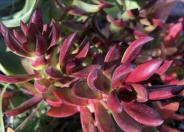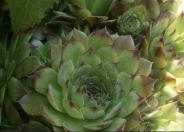
Common name:Ghost Plant
Botanical name:Graptopetalum paraguayense
Ghost plant is an unusually colored small succulent from Mexico with 3 to 6 inch wide rosettes. The range of color is part of the great charm of this plant. The color ranges from pale blue, light pink, to light purple. The plant multiplies rapidly and is easy to propogate. In spring, it has white flowers that have small red touches. It does well in full sun to light shade and prefers well-drained soil. Irrigate infrequently to occasionally although it does not like wet feet so good drainage is critical if watering regularly.

Common name:Burgundy Jade
Botanical name:Crassula platyphylla ‘Burgundy’
The Crassula Platyphylla’ Burgundy’ is a slow-growing plant that only reaches about six inches in height. The plant doesn’t develop an extensive root system, and it typically grows in dense clusters. It is a succulent plant with thick, fleshy leaves; native to South Africa, it is the only variety of the species that has burgundy-colored leaves. Cool weather intensifies the color. Crassula platyphylla will thrive in a position that is exposed to plenty of sun, but it does not tolerate full-sun exposure. Instead, this type of plant prefers partial shade. The sun should not shine directly on the leaves for more than six hours per day, which is why this type of succulent prefers partial shade. This plant needs to be watered at least once per week, and the soil should not be allowed to dry out. Rainwater is preferred over tap water because it does not contain any chlorine or fluoride that could damage your plants. Crassula platyphylla succulents need a very well-draining mix in their pots so that they don’t rot from too much water staying on them for extended periods. But before planting your plant, make sure to add some compost as this will increase drainage even more! This houseplant does best in humid conditions around 60% relative humidity. The best place to grow these plants is indoors and in a pot with drainage holes and porous dry soil with enough organic material for the plant to thrive on. You should prune any time the Crassula begins growing larger than desired or starts getting too leggy and “stringy.”

Common name:Catalina Live-Forever
Botanical name:Dudleya hassei
Dudleya hassei is a succulent ground cover with gray, finger-like, swollen leaves that only reaches 6" tall but may spread several feet. Long vertical stems appear in spring, with white flowers. Hummingbirds love this plant. It does best in coastal areas in full sun and infrequent but deep irrigation. It prefers sandy, well draining soil. This plant looks great in containers and around rock outcroppings.

Common name:Mosaic Aloe
Botanical name:Aloe hemmingii
Aloe hemmingii is best known to be a beautiful looking succulent. As the plant matures expect it to reach up to 10" in diameter. The plants main feature are the almost glowing green fleshy leaves with yellowish spots around the leaves. It should not sit on the water, and an excess amount of water should be avoided. The best way of watering is soak and dry method this succulent. This succulent is a unique one that blooms in the spring, with yellow to red flowers. It is a nice addition to your collection of plants especially if you have it displayed in a beautiful pot. Aloe hemmingii needs strong light. Full to partial sun is the best for its growth. It is better to grow outdoors rather than indoors. A well-drained soil mixture is essential.

Common name:Hens and chicks, houseleek, roof ho
Botanical name:Sempervivum tectorum
Sempervivum tectorum is a low-growing evergreen succulent that looks a little like rubbery roses with thick, fleshy pads arranged in rosettes. The leaves are usually pointed and some have purple tips or they may grow in shades of red. They are considered alpine or rock garden plants, because of their hardiness and drought resistance. The original hen rosette produces tiny rosette offsets known as the chicks. They are slow-growing plants, and they remain evergreen throughout the year, even in cold climates. Mature plants produce an odd-looking thick flower stalk with star-shaped flowers at the tip of mauve-pink or red. These are not tall plants, except when they stretch out to flower. The flower stalk extends 8 to 12 inches before flowering, then reduces in size once the plant blooms and the mother plant dies. Hens and chicks are not grown for their flowers, but when they do bloom, it is usually during the summer. Plant them in late spring, when there's no longer a chance of frost and it's still not too hot outside. Planting a large patch, using them along edges, or mixing them in a container garden will help them stand out. Another option is to mix hens and chicks with creeping sedum which can make a lawn alternative where there is no foot traffic. If you have a rock garden or rock wall, you have the perfect environment for growing hens and chicks. Tuck them into the crevices or let them drape over a rock wall. Stone provides the perfect balance of drainage, radiant heat, and root protection. Hens and chicks will spread by underground roots. During the growing season, expect each plant to multiply itself by at least four, by producing little offset plantlets all around the perimeter of the hen. These chicks can be snapped off and replanted elsewhere at any time. Once established, the maintenance of hens and chicks is minimal. You’ll need to remove the old hens, after they flower, and divide chicks as needed. They are tough plants that survive just about any condition, even frost and cold. Hens and chicks prefer a spot in full sun but will appreciate some afternoon shade if planted in extremely hot climates. Hens and chicks, as with most succulents, need excellent drainage. Poor, sandy soil would be just fine. You could work some peat into heavier soil, to lighten it and improve drainage. Soil pH should be in the neutral range, 6.6 to 7.5. Except in extremely hot, dry situations, you won’t need to give this plant any supplemental water. They prefer an average climate between 65 and 75 degrees Fahrenheit. If temperatures drop too low, they will not necessarily die off but will stop growing and go into a semi-dormant state. No fertilizer is needed.
Designer: Sherman Library and Gardens
Photographer: Anne Chilcott
Maintain a two to four inch layer of mulch on the soil surface to reduce weeds, infiltrate rain water, and reduce compaction.
Develop healthy soil for plants that are vigorous and naturally pest-resistant.